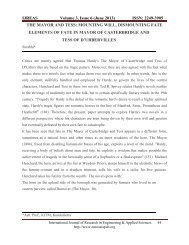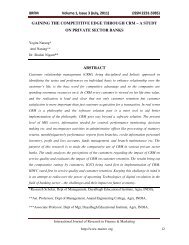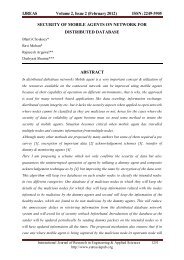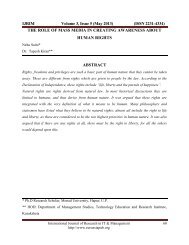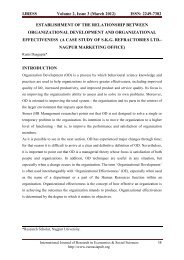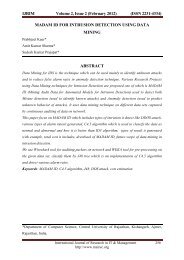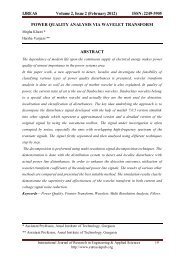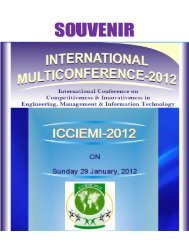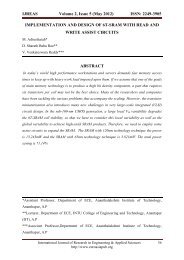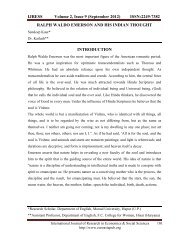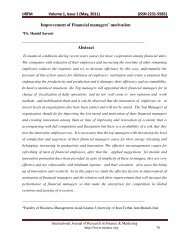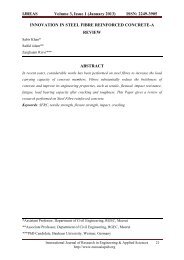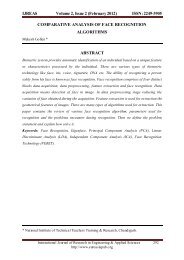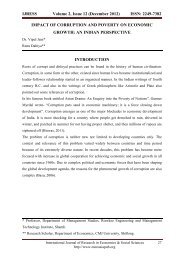Test of hypothesis using Sandler's A-test and ... - Euroasiapub.org
Test of hypothesis using Sandler's A-test and ... - Euroasiapub.org
Test of hypothesis using Sandler's A-test and ... - Euroasiapub.org
- No tags were found...
Create successful ePaper yourself
Turn your PDF publications into a flip-book with our unique Google optimized e-Paper software.
IJRESS Volume 2, Issue 2 (February 2012) ISSN: 2249-7382IMPACT OF INNOVATION IN THE MANAGEMENT EDUCATIONMETHODS: TEST OF HYPOTHESIS USING SANDLER’S A-TESTAND PAIRED T-TESTDr. Chanchal Vashishtha *Poonam Khurana **Madhu Arora ***ABSTRACTTo meet the challenges <strong>of</strong> the exp<strong>and</strong>ing education scenario insufficient resources <strong>and</strong>facilities there is a need to use different teaching methodology. i.e. the process fit for thebenefit <strong>of</strong> students. In a rapidly changing <strong>and</strong> highly competitive educational environment, noinstitute can afford to remain static. Recently growing competition in institutes have beenpursuing aggressive teaching strategies to provide new heights The main distinguishcharacteristics <strong>of</strong> any institution is its faculty <strong>and</strong> the knowledge resources generated bythem. The knowledge resources like student learning material <strong>and</strong> research work created bythe faculty members are to be properly stored <strong>and</strong> shared among faculty members <strong>and</strong>students <strong>of</strong> the institute. It is also necessary to <strong>test</strong> its significance scientifically. The presentstudy is diagnostic/ experimental as well as <strong>hypothesis</strong> <strong>test</strong>ing in nature which is primarydata based experimental study a new knowledge management practice has been <strong>test</strong>ed <strong>using</strong>S<strong>and</strong>ler’s A- <strong>test</strong> <strong>and</strong> paired t-<strong>test</strong>. Findings suggest that KM practice showed significantresults <strong>and</strong> should be recommended.Keywords: t-<strong>test</strong>, A- <strong>test</strong>, Significance, Hypothesis.* Principal, Fairfield Institute <strong>of</strong> Management <strong>and</strong> Technology, G.G.S.I.P. University, Delhi.** Assistant Pr<strong>of</strong>essor, CPJ Institute <strong>of</strong> Advanced Studies, Narela.*** Assistant Pr<strong>of</strong>essor <strong>and</strong> Programme Co-ordinator, Fairfield Institute <strong>of</strong> Management <strong>and</strong>Technology, G.G.S.I.P.University, Delhi.International Journal <strong>of</strong> Research in Economics & Social Sciences 525http://www.euroasiapub.<strong>org</strong>
IJRESS Volume 2, Issue 2 (February 2012) ISSN: 2249-7382INTRODUCTIONThe future <strong>of</strong> a country depends on 2 T’s; Teacher <strong>and</strong> Trade. The main distinguishcharacteristics <strong>of</strong> any institution is its faculty <strong>and</strong> the knowledge resources generated bythem,in India trade has got polichift from regulation to de- regulation, from state control toprivate initiative, from domestic focus to global focus. Finance has come in for a great deal <strong>of</strong>criticism after the global financial crisis <strong>of</strong> 2007 <strong>and</strong> 2008. Clearly there were seriousproblems with finance as it was practiced in the years before the crisis. To the extent that thiswas only a gap between theory <strong>and</strong> practice, there is a need for finance practice to go back toits theoretical roots (Jayanth R Verma 2011). But this change fueled by IT, Internet <strong>and</strong>genuine recognition <strong>of</strong> human capital as the driver <strong>of</strong> new economy has triggered paradigmshift in management education. Globalization has caused business schools to look atInternational Business, focus on producing graduates with global mindsets <strong>and</strong> to developlinks with schools overseas. Based on articles published between 2000 <strong>and</strong> 2010, it has beenfound that there is an urgent need to develop <strong>and</strong> design a system <strong>of</strong> continuous qualityimprovement <strong>of</strong> B-Schools in India where steel, power <strong>and</strong> oil industry have alreadyestablished excellent executive education center.It has also been recommended that a great level <strong>of</strong> innovation is required in functional <strong>and</strong>sectored schools in the fields <strong>of</strong> management education like agriculture, rural, forest, cooperative<strong>and</strong> plantation management.REVIEW OF LITERATURE:Corporate sector is investing in resources to conduct training program <strong>and</strong> are deeplyambitious in grooming the global leaders for international positions. These companies alsocreate platform for strategic discussions in every batch by driving the team to draw a futurestrategy that is implementable.To meet the challenges <strong>of</strong> the exp<strong>and</strong>ing educational scenario, insufficient resources <strong>and</strong>facilities there is need to teach differently i.e. the process fit for the benefit for students.60 college students taking introductory psychology were r<strong>and</strong>omly divided into 4 groups. The1st 3 groups attended a lecture <strong>and</strong> received either outlines <strong>of</strong> the lecture material, examples<strong>of</strong> the concepts in the lecture, or no supplementary materials. The 4th group did not attend thelecture but instead received a typed transcript <strong>of</strong> it. Ss receiving outlines or lists <strong>of</strong> examplesscored significantly higher on follow-up objective examinations than Ss receiving eithertranscripts or no supplementary materials; Ss receiving transcripts did not differ significantlyin scoring from Ss who attended the lecture but did not receive supplementary materials.International Journal <strong>of</strong> Research in Economics & Social Sciences 526http://www.euroasiapub.<strong>org</strong>
IJRESS Volume 2, Issue 2 (February 2012) ISSN: 2249-7382Groups also differed in time spent preparing for the exams. Northcraft, G. B.; Jernstedt, G.C.(1975)A study to investigate MBA students' attitudes about how teaching methodologies <strong>and</strong>instructor characteristics affect their learning in North Carolina. suggested that theparticipants overwhelmingly support the use <strong>of</strong> real world examples in class, followed byopen classroom discussion, as the approaches that most positively influence their learning.The participants also reveal that instructors’ most important characteristics that may helptheir learning include the following in the order <strong>of</strong> importance: communication skills,knowledge <strong>of</strong> the subject matter, overall attitudes, fairness, <strong>and</strong> general personality. AhmadTootoonchi, Paul Lyons, Abdalla Hagen(2002).Article by Joanna <strong>and</strong> Scott described <strong>and</strong> presented examples <strong>of</strong> how three teachingmethodologies—problem-based learning, intentional learning environments, <strong>and</strong> cognitiveapprenticeship—employ these instructional features. Several instructional features facilitatethe development <strong>of</strong> metacognitive <strong>and</strong> self-directed learning skills, <strong>and</strong> the disposition tolifelong learning: (1) student autonomy, responsibility, <strong>and</strong> intentionality; (2) intrinsicallymotivating learning activities; (3) enculturation; (4) discourse <strong>and</strong> collaboration amonglearners; <strong>and</strong> (5) reflection. (Joanna C. Dunlap ,† , Scott Grabinger,2003)It was observed in the study thatImportance <strong>of</strong> faculty underst<strong>and</strong>ing <strong>and</strong> acknowledgingdifferent student personality types <strong>and</strong> related learning preferences as a way to initiateimprovement <strong>of</strong> undergraduate dental education, promote student motivation, <strong>and</strong> allowfor an expression <strong>of</strong> learning style preference.(Stephen A. Jessee, D.D.S.; Paula N. O’Neill,M.Ed., Ed.D.; Robert O. Dosch, D.D.S.)RESEARCH METHODOLOGYThe design <strong>of</strong> the research helps to get the ways for doing the work. Summary <strong>of</strong> theproposed research work is given as under:As the purpose <strong>of</strong> research is to discover answers to questions through the application <strong>of</strong>scientific procedures, research objectives can be one <strong>of</strong> the following categories:1. Exploratory research to gain familiarity with a phenomenon or to achieve newinsights into it.2. Descriptive research is to portray accurately the characteristics <strong>of</strong> a particularindividual, situation or a group.3. Diagnostic research is to determine the frequency with which something occurs orwith it is associated with something else.International Journal <strong>of</strong> Research in Economics & Social Sciences 527http://www.euroasiapub.<strong>org</strong>
IJRESS Volume 2, Issue 2 (February 2012) ISSN: 2249-73824. Hypothesis <strong>test</strong>ing research to <strong>test</strong> a <strong>hypothesis</strong> <strong>of</strong> a causal relationship betweenvariables.The present study is diagnostic/ experimental as well as <strong>hypothesis</strong> <strong>test</strong>ing in nature.RATIONALE OF THE STUDY:In a rapidly changing <strong>and</strong> highly competitive educational environment, no institute can affordto remain static. Recently growing competition in institutes have been pursuing aggressiveteaching strategies to provide new heights. Present study has been experimented on a group<strong>of</strong> finance students with the use <strong>of</strong> Null Hypothesis collecting primary data.OBJECTIVES OF THE STUDY:To examine the present status <strong>of</strong> traditional practice used in classroom.To explore the role played by new KM practice in improving performance.To identify the factors contributing positively or negatively after <strong>using</strong> new KMpractice.To suggest usefulness <strong>of</strong> implication <strong>of</strong> practice, if any.These objectives have been achieved through a series <strong>of</strong> logical steps. Based on thestudy <strong>of</strong> observed results <strong>test</strong>ed hypotheses on reliable <strong>test</strong>s.RESEARCH DESIGN:It is the framework <strong>of</strong> article, which stimulates what information, is to be collected, fromwhich source <strong>and</strong> by which procedure.Hypothesis: Null <strong>hypothesis</strong> is assumed that the two experiments will give same results.Value α has been fixed at 5% level <strong>of</strong> significance.Null Hypothesis H 0 :µ : experiment A=experiment B.Alternative Hypothesis H α µ : experiment A≠experiment B.Data collection: The present study is based on primary data.Analysis <strong>of</strong> Data: Data has been analysed with the S<strong>and</strong>ler A <strong>test</strong> <strong>and</strong> T statistics nonparametric <strong>test</strong>s.Interpreting <strong>and</strong> ReportingFinally the researchers have to prepare the report <strong>of</strong> what has been done by them in the form<strong>of</strong> conclusion.Problems Encountered by Researchers <strong>and</strong> scope for further research:1. Time Constraint.2. Limitation <strong>of</strong> Data Resources.3. Vastness <strong>of</strong> the SubjectInternational Journal <strong>of</strong> Research in Economics & Social Sciences 528http://www.euroasiapub.<strong>org</strong>
IJRESS Volume 2, Issue 2 (February 2012) ISSN: 2249-7382Analysis <strong>of</strong> data:A <strong>test</strong> developed by Joseph S<strong>and</strong>ler has been used by the researcher as correlated samples areemployed <strong>and</strong> hypothesized mean difference is taken as Zero. i.e.H 0 : µ D = 0 .A = The Sum <strong>of</strong> Squares <strong>of</strong> the differencedthe Squares <strong>of</strong> the sum <strong>of</strong> the difference=∑D 2 )2i /∑ (D iWe have the computed value <strong>of</strong> A has been compared with its corresponding table value fordrawing inference concerning acceptance or rejection <strong>of</strong> null <strong>hypothesis</strong>. As if the calculatedvalue <strong>of</strong> A is equal or less than the table value, A statistics is considered significant whereupon researcher can reject H 0 <strong>and</strong> accept H α . But if the calculated values <strong>of</strong> A is more than itstable value, then A statistics is taken as insignificant <strong>and</strong> accordingly researcher can acceptH 0EMPIRICAL RESULTS AND DISCUSSIONS:Table 1 depicts the statistics about differences <strong>of</strong> variable A <strong>and</strong> BTable 1: Formulae UsedFor S<strong>and</strong>ler A <strong>test</strong> = ∑D 2 )2i /∑ (D iFor paired T-<strong>test</strong> = D¯-0/ σdiff./(n) 1/2D¯ = ∑ D i/nTable 2 results are based on paired observations for the experimental group concerning anexperiment involving 2 different aspects <strong>of</strong> teaching methodology <strong>of</strong> finance performed on asingle group <strong>of</strong> MBA students.Table 2(X i -Y i )2D i-4 16-6 3612 144-7 49-10 100-3 9-11 121-14 196-3 9International Journal <strong>of</strong> Research in Economics & Social Sciences 529http://www.euroasiapub.<strong>org</strong>
IJRESS Volume 2, Issue 2 (February 2012) ISSN: 2249-7382-2 4-9 81-15 225-6 3610 100Source : Authors’ own calculations based on primary data.After applying one tailed <strong>test</strong> (in the left tail) because H α is <strong>of</strong> less than type for determiningthe rejection region at 5% level <strong>of</strong> significance which comes to as <strong>using</strong> the table <strong>of</strong> t-distribution for 14 degrees <strong>of</strong> freedom. Hence Null <strong>hypothesis</strong> has been rejected. ExperimentB was better than experiment A. Methodology used for students was successful as R:t
IJRESS Volume 2, Issue 2 (February 2012) ISSN: 2249-73828. Varma, Jayanth R, Finance Teaching <strong>and</strong> Research after the Global Financial Crisis,IIMA _ INDIA,Research <strong>and</strong> Publications,W.P. No. 2011-03-02,March 2011International Journal <strong>of</strong> Research in Economics & Social Sciences 531http://www.euroasiapub.<strong>org</strong>



